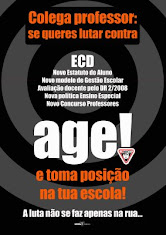Neste blogue praticam-se a Liberdade e o Direito de Expressão próprios das Sociedades Avançadas
Diz o texto que agora com as tecnologias as crianças podem resolver os TPC e têm mais tempo para brincar? Onde? Como tem sido sempre dentro de uma sala de aula, só que agora deixando-os entregues a jogos?
Há realmente trabalho colaborativo?
Just about every classroom in the public system now has an interactive smart board, instead of the old fashioned blackboard.
Na realidade,em quantas escolas?
E fala da Fundação do momento: Fundação das Comunicações Móveis (a que foi acusada de fundação fantasma pelo PSD)
Toda a notícia aqui
Note to President Obama: Want to Fix the Schools? Look to Portugal!
President Obama already knows that the nation's schools are failing a large number of young Americans. One-third of all students drop out before finishing high school. It's a terrible record, and it's even worse in inner city public schools, where only half of blacks and Hispanics graduate from school. This is not a legacy that would make anyone proud: More young Americans on a proportionate basis drop out of school today than at any other time in our history.
This problem is undoubtedly complicated, but one of the reasons why many American youth are unmotivated and not learning well is that they're bored in school. They're grown up in a fast paced, challenging digital world, with the Internet, mobile devices, video games and other gadgets. They watch less television than their parents did and TV is typically a background activity. They are a generation doesn't like to be broadcast to and they love to interact, multi-task and collaborate. Yet, when they get into the classroom, they're faced with stale textbooks and lectures from teachers who are still using a nineteenth century innovation, chalk and blackboard.
American classrooms need to enter the 21st century. Thousands of teachers agree. Earlier this year, several important educational groups urged the president and Congress to spend nearly $10 billion to improve technology in the classroom, and ensure teachers know how to use computers most effectively.
To show the way, I suggest the president take a look at a modest country across the Atlantic that's turning into the world leader in rethinking education for the 21st century.
That country is Portugal. Its economy in early 2005 was sagging, and it was running out of the usual economic fixes. It also scored some of the lowest educational achievement results in western Europe.
So Prime Minister Jose Socrates took a courageous step. He decided to invest heavily in a "technological shock" to jolt his country into the 21st century. This meant, among other things, that he'd make sure everyone in the workforce could handle a computer and use the Internet effectively.
This could transform Portuguese society by giving people immediate access to world. It would open up huge opportunities that could make Portugal a richer and more competitive place. But it wouldn't happen unless people had a computer in their hands.
In 2005, only 31% of the Portuguese households had access to the Internet. To improve this penetration, the logical place to start was in school, where there was only one computer for five kids. The aim was to have one computer for every two students by 2010.
So Portugal launched the biggest program in the world to equip every child in the country with a laptop and access to the web and the world of collaborative learning. To pay for it, Portugal tapped into both government funds and money from mobile operators who were granted 3G licenses. That subsidized the sale of one million ultra-cheap laptops to teachers, school children, and adult learners.
Here's how it works: If you're a teacher or a student, you can buy a laptop for 150 euros (U.S. $207). You also get a discounted rate for broadband Internet access, wired or wireless. Low income students get an even bigger discount, and connected laptops are free or virtually free for the poorest kids. For the youngest students in Grades 1 to 4, the laptop/Internet access deal is even cheaper -- 50 euros for those who can pay; free for those who can't.
That's only the start: Portugal has invested 400 million euros to makes sure each classroom has access to the Internet. Just about every classroom in the public system now has an interactive smart board, instead of the old fashioned blackboard.
This means that nearly nine out of 10 students in Grades 1 to 4 have a laptop on their desk. The impact on the classroom is tremendous, as I saw this spring when I toured a classroom of seven-year-olds in a public school in Lisbon. It was the most exciting, noisy, collaborative classroom I have seen in the world.
The teacher directed the kids to an astronomy blog with a beautiful color image of a rotating solar system on the screen. "Now," said the teacher, "Who knows what the equinox is?"
Nobody knew.
"Alright, why don't you find out?"
The chattering began, as the children clustered together to figure out what an equinox was. Then one group lept up and waved their hands. They found it! They then proceeded to explain the idea to their classmates.
This, I thought, was the exact opposite of everything that is wrong with the classroom system in the United States.
The children in this Portuguese classroom were loving learning about astronomy. They were collaborating. They were working at their own pace. They barely noticed the technology, the much-vaunted laptop. It was like air to them. But it changed the relationship they had with their teacher. Instead of fidgeting in their chairs while the teacher lectures and scrawls some notes on the blackboard, they were the explorers, the discoverers, and the teacher was their helpful guide.
Yet too often, in the U.S. school system, teachers still rely on an Industrial Model of education. They deliver a lecture, the same one to all students. It's a one-way lecture. The teacher is the expert; the students are expected to absorb what the teacher says and repeat. And students are supposed to learn alone.
Teachers often feel that this is the only way to teach a large classroom of kids, and yet the classroom in Portugal shows that giving kids laptops can free the teacher to introduce a new way of learning that's more natural for kids who have grown up digital at home.
First, it allows teachers to step off the stage and start listening and conversing instead of just lecturing. Second, the teacher can encourage students to discover for themselves, and learn a process of discovery and critical thinking instead of just memorizing the teacher's information. Third, the teacher can encourage students to collaborate among themselves and with others outside the school. Finally, the teacher can tailor the style of education to their students' individual learning styles.
It's not easy to change the model of teaching. In fact, this is the hard part. It's far easier to spend money, as Portugal did, to put Internet into the classroom and equip the kids with laptops. ( By now, half of high school students now have them, as do four in 10 middle school students.)
Yet Portugal has been careful to invest in teacher training to capitalize on the possibilities of the laptops in schools. They're also thinking of creating a new online platform to allow teachers to work together to create new lessons and course materials that take advantage of the interactive technology. Through this collaboration, the Portuguese school system will create exciting new online materials to educate children. Lots of ideas are already making their way into Portuguese classrooms, says Mario Franco, chair of the Foundation for Mobile Communication, which is managing the e-school program. There are 50 different educational programs and games inside the laptops the youngest children use. The laptops are even equipped with a control to encourage kids to finish their homework and score high marks. If they do, they get more time to play.
It's too early to assess the impact on learning in Portuguese schools. Studies of the impact of computers in schools elsewhere have been inconclusive, or mixed. One key problem is that simply providing computers in schools is not enough. Teachers facing a classroom of kids with laptops need to learn that they are no longer the expert in their domain; the Internet is.
Yet Portugal is on a campaign to reinvent learning for the 21st century. The technology is only one part of that campaign. The real work is creating a new model of learning.
I believe this could help the U.S. revive students' interest in school and perhaps keep them in school long enough to graduate, and even go to college. It would be a substantial investment. It's estimated that the total cost of giving a computer to each student, including connection to networks, training, and maintenance, is over $1,000 per year.
Yet after seeing the promise of the exciting classrooms in Portugal, I'm convinced it is worth it. Your child should be so fortunate.






























































0 commentaires:
Enviar um comentário